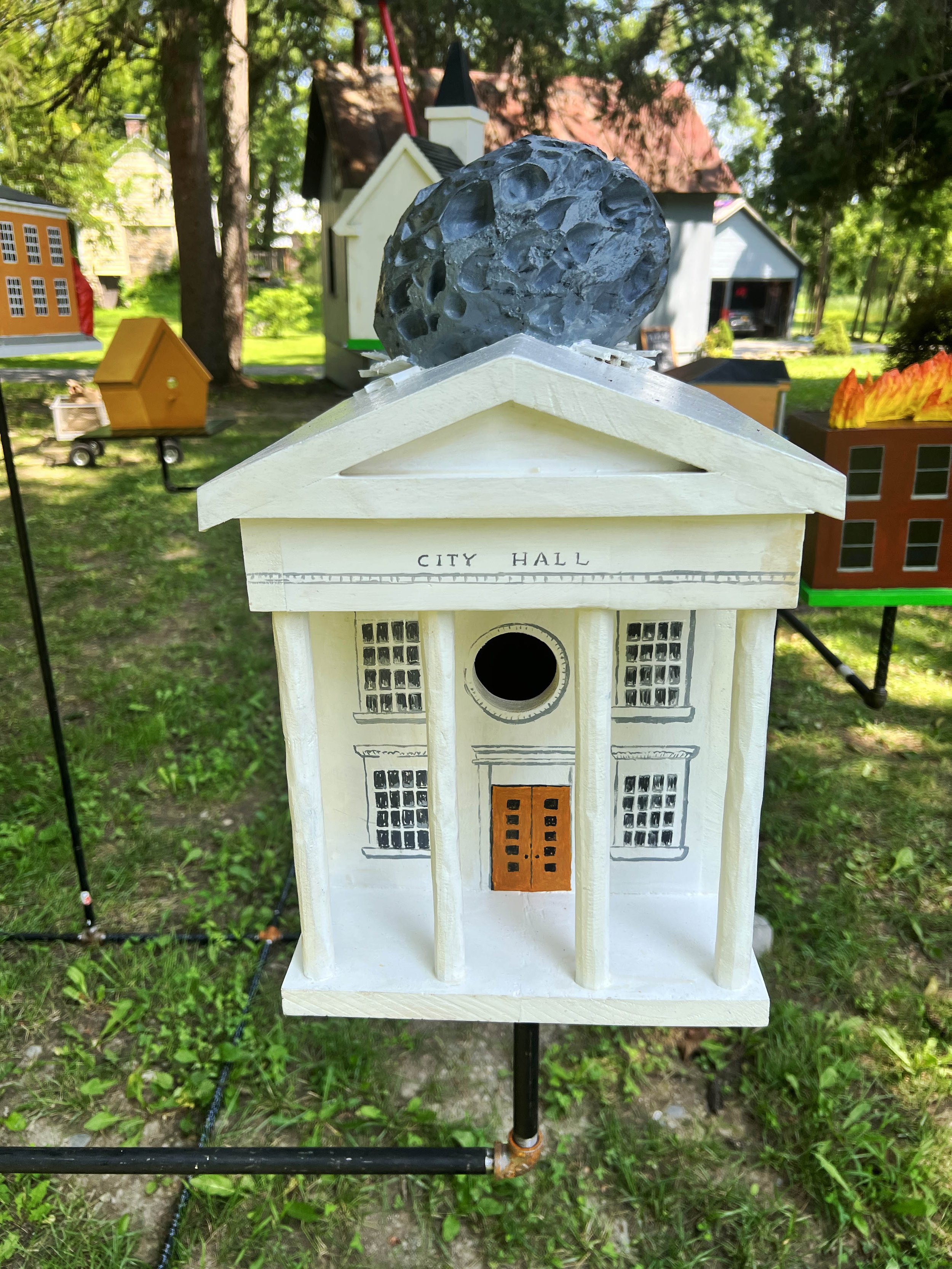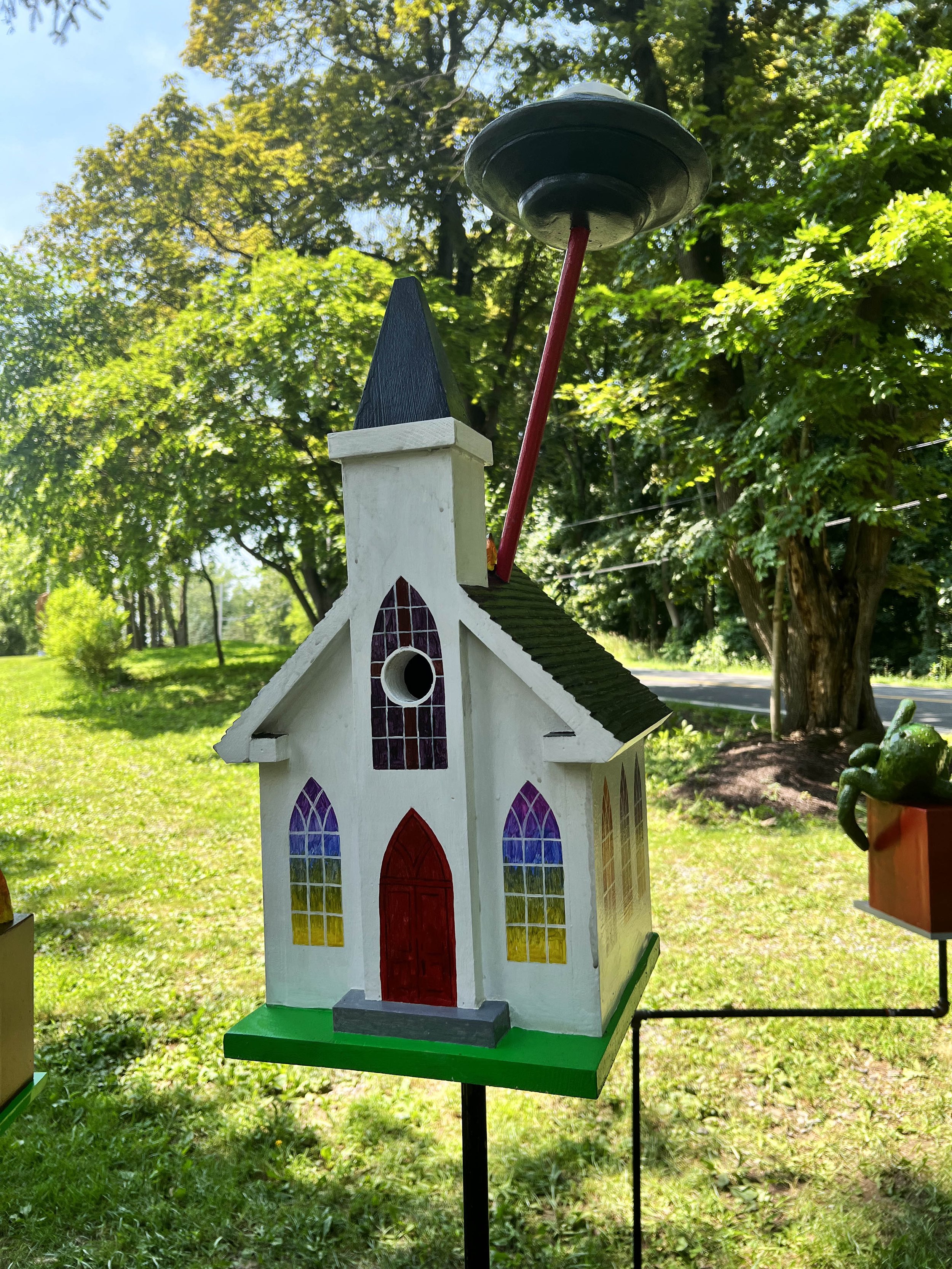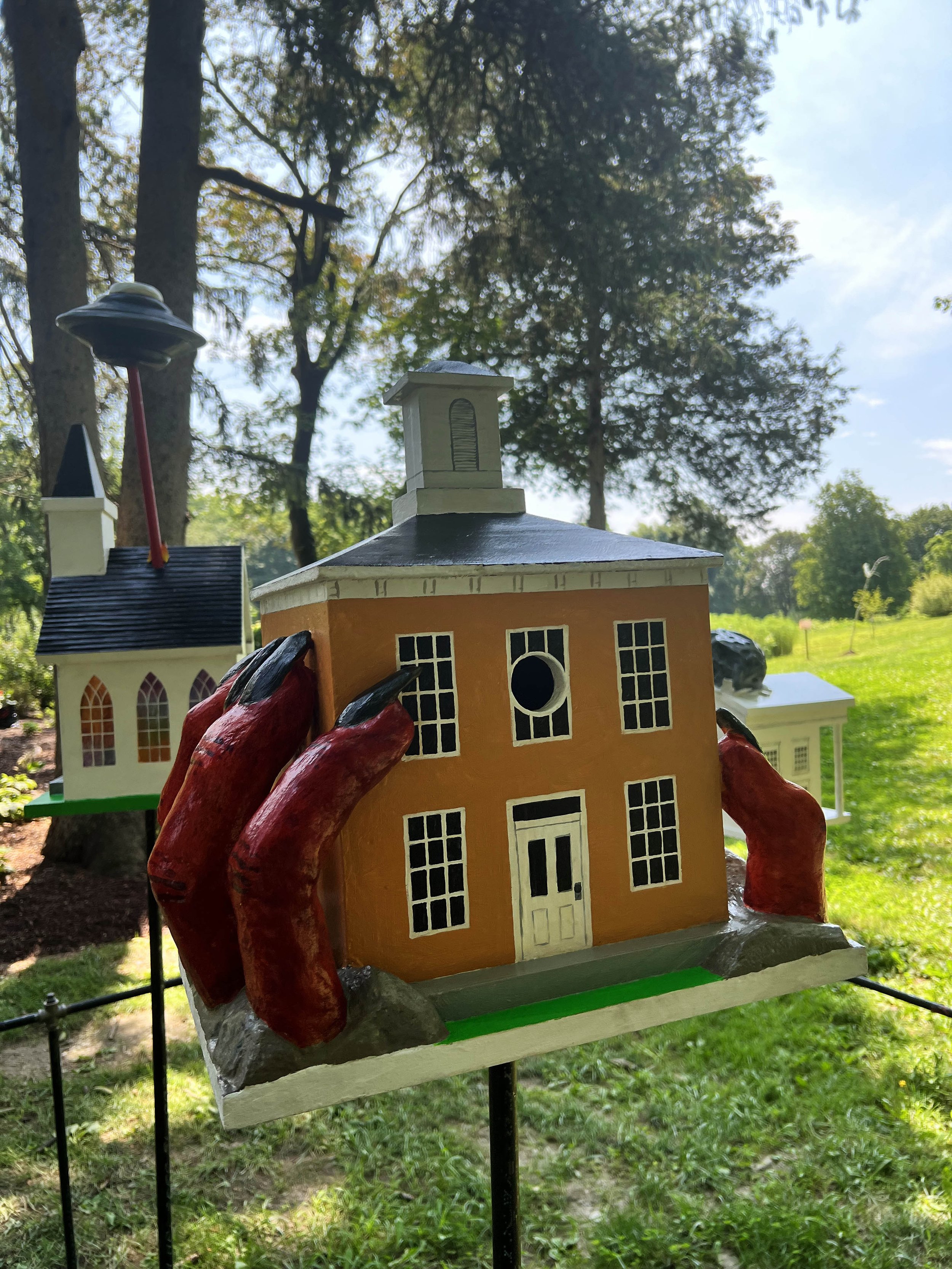PAR·LEY
July 21- Sep 4, 2023
Mother-in-law’s Gallery
140 Church Avenue
Germantown, NY 12526
Upstate Art Weekend : July 21-24
Artist Reception : July 22, 6-8pm
Closing Party : Sep 4th
Lauren Cohen performs “Brian’s Yard Sale”
July 21st 12-6pm, July 22nd 12-8pm, July 23rd 12-6pm
Featuring:
Amelia Biewald, Amanda Browder, Lauren Cohen, Andrea Sherrill Evans, Rachel Frank, Paul Gagner, David Herbert, Leander Knust, Alison Kudlow, Casey Miller, Marianna Peragallo, Lara Saget
Field Projects is pleased to present Par·ley, a group exhibition in collaboration with Mother-In-Law Gallery taking place on the surrounding grounds outside of the exhibition space.
The curtilage of our homes has always been a space where we negotiate with Nature. We plant, prune, uproot, foster, weed, govern and curate this space. Nature, in turn, does everything possible to reclaim, reroot and rewild it, reminding us that for now we may manipulate nature but we are also governed by Nature.
Par·ley brings together a group of artists under the arch of this negotiated space and examines different methods of living with and parallel from nature.
Amelia Biewald
‘Permanence in Change’ is a poem by J.W. Goethe who was a big player in the proto-Romantic movement in late 18th century Europe. The poem deals with the ruin and metamorphosis of all living things. It’s theatrical, emotional and gothic, a bit irrational and plays into my interest in the fluidity of nature.
“Permanence in Change”, 2023, mixed media installation, dimensions variable $7200
“Permanence in Change”, 2023, mixed media installation, dimensions variable $7200
Our City Sunshine : St Charles, IL 2021, Donated fabric from the city of St Charles, IL. Sandbags, wire. Price on Request
Amanda Browder
Fabric unites stories, amplifies voices and creates moments of meaning. This work supports non-hierarchical formulations of craft vs. art, and fosters community participation through sewing and dialogue and community participation as a way to connect with others in a time of complex change in our society. Socially based constructs in the public realm inform my work in tandem with my delightful bag-of-tricks: mathematics, color, symmetry, scale and people who are always my truth. The dialog between craft and art is in the work, complementing criticality, and conversation in a site-specific response. My approach signifies that “The artist” is not one, but rather an evolving network of participants and spectators and collaborators. Sculptural gesture and painterly pause are challenged by the fluidity of textiles paralleling craft history in which most artists remain anonymous, the work transcends individual identity to become an expression of a focussed social collective. This specific piece was originally created in 2021 in St. Charles, IL with the St. Charles Arts Council. All the fabric was donated by the citizens of the St. Charles area, and was sewn together with volunteers from the area. It was built during the pandemic and was displayed on the St. Charles Municipal Center.
Brian’s Yard Sale
Lauren Cohen
In the depths of her emotional solitude during the pandemic, artist Lauren Cohen embarked on a creative venture, making fictional characters who are in pursuit of love. Brian emerged as a composite embodiment of all that Cohen cherishes and fears in the opposite sex and in herself. Rooted in her personal odyssey to mend deep-seated traumas, the artist explores love’s intricate dynamics with an exciting upcoming event. Cohen’s character, Brian, is having a yard sale at Mother-in-Law’s Gallery in Germantown, NY. The exhibition is curated by Field Projects and will display over 100 ceramic household objects, each imbued with the essence of Brian. Visitors are invited to rummage through various oddities that have been born out of the interior spaces of the artist’s psyche. A range of Brian’s collections will be on display; heart-rocks, sporks, games, an “ass” ash tray, plate ware and tea sets that bear a striking resemblance to Brian’s deceased German Shepherd dog. Within the realm of material possessions, the adage of “one man’s trash is another man’s treasure” resounds with profound truth, reminding us of the innate subjectivity that governs our perception of worth.
On Summer's Margin, 2023, Inks made with dandelion flowers, ground ivy, black walnuts, black cherry bark, a mix of flowers from Jessica’s garden, cattails, honeysuckle vines & leaves, spruce cones, rocks, pieces of worn red brick, and charcoal made with fallen willow & other tree branches, gathered on the grounds of Mother-in-Law's Gallery in Germantown, NY in late May 2023 (with color modifiers of alum, vinegar, soda ash, and iron), on handmade abaca paper with dandelion flowers, ground ivy, cattails, and flowers from Jessica’s garden, $550 unframed, $650 framed. Botanical Ink Sample Markers, 2023, Inks made with dandelion flowers, ground ivy, black walnuts, black cherry bark, a mix of flowers from Jessica’s garden, cattails, honeysuckle vines & leaves, and spruce cones, gathered on the grounds of Mother-in-Law's Gallery in Germantown, NY in late May 2023 (with color modifiers of alum, vinegar, soda ash, and iron), on digital prints framed with PE-LD sheets and copper tape on wood stakes, Custom site-specific Botanical Ink Sample Markers available by commission; price on request..
Andrea Sherrill Evans
On Summer’s Margin is a series of site-responsive drawings that explore nuanced interconnections between the local ecology and human activity within the landscape surrounding Mother-in-Law’s Gallery in Germantown, NY. Using a palette of drawing media created with native and introduced plants gathered on site in late May, this work references interwoven natural and built features that dot the land. Images of dry stacked fieldstone, brush piles, and mown paths—rendered on handmade paper with inks derived from black cherry bark, ground ivy, and dandelion flowers—provide a window into the past and present history of the place. Installed throughout the grounds of the gallery, a group of framed drawings remain protected while their unframed counterparts weather under the late summer exposure. Over time, the fugitive quality of this work’s organic matter is heightened, allowing fabricated boundaries between the natural and human world to soften, blend, and fade.
Chrysalid Offering Vessel: Ibis, Mangrove, Oyster, 2023, Stoneware ceramic, glazes, zip ties, rope, spray paint, pond liner, water, pump, 26.5 x 25.5 x 25.5” (with pond liner), $7,000
Rachel Frank
I have been working on a series of ceramic works based on ancient Eurasian offering vessels. This on-going series includes the rhyton, an animal shaped vessel and the lekythos, a narrow vessel associated with funeral rites and loss. Many of my forms take the shape of various sentinel or indicator species—plants or animals whose health or absence offer early signals of environmental change. This particular vessel includes mangroves (which protect coatlines and act as a carbon sink), Oysters (which filter and clean water) and the ibis a bird that annually migrates though the NYC area and is posed in a position mimicking the Christian "pelican of piety" (a symbol of sacrifice). Many of my vessels take the form of various types of birds. I work as a wildlife rehabilitator and animal care manager at the Wild Bird Fund in NYC and specialize in the care of waterfowl, shorebirds, and raptors. I view birds as symbolic of movement—migration, seasonal change, transformation—and the offering vessel form conceptually alluding to the processes of collection, exchange, and engagement between species. The fountain made for Upstate New York is also intended to attract birds and insects, encouraging new ceremonies of ritual and community between various species.
Calamityville; 2023; wood, iron, foam, acrylic; $8,000 (or $800 per birdhouse; 10 total)
Paul Gagner
For the past few years, I’ve been making birdhouses as a way of creating art for the natural world. With this piece, I was considering these “houses” to be architecture common to a small town or village. This includes a school, library, city hall, fire dept, etc. I thought it would also be humorous to create miniature dramas for the “actors” or residents of this small village. Each one has it’s own tragic story that’s unfolding.
SUMMER BABE 2023 coroplast, hot glue, wood, polyurethane glue, paint, and hardware $25,000
David Herbert
“I love to open a book of fantasy and encounter an ink drawn map of the world I am about to enter. I think of my sculptures as landmarks on such a map. SUMMER BABE is at the crossroads of Ancient Greek Kouros and Wicker Man.”
Public Grill - 2023 - Steel, Copper, Paint - $6,600
Leander Knust
The Grill in Public Grill was acquired when 1960's public barbeques at a rest stop in Maine were removed, their welcoming leisurely roadside cook-out no longer. To honor these public grill's ubiquitous service to a populous that deserves a rest, this specific defunct specimen has been grown-over with electro-formed copper (a make over of sorts) and installed again for continued use and upgraded purpose.
The Sun, The Center, The Beginning, and The End - double: 14” X 27” X 18”, $3000
Alison Kudlow
These pieces, made of ceramic and glass, are based on stromatolites, mounds of sedimentary rocks formed by the growth of layer upon layer of cyanobacteria. Cyanobacteria are a single-celled photosynthesizing microbe. A felt of cyanobacterial filaments traps sediment grains that wash across the surface, forming a rock layer. A fresh layer of microbes then grows over that, and the process repeats. Its layers described a passage of time and a process of growth, the geological equivalent of rings on a tree. Although small and simple, cyanobacteria fatefully changed the Earth. As photosynthesizers, cyanobacteria produce oxygen as a by-product. Stromatolites became common 2.5 billion years ago, gradually changing the Earth's atmosphere from a carbon dioxide-rich mixture to the present-day oxygen-rich atmosphere. This major shift paved the way for the next evolutionary step and eventually made the Earth habitable for us humans. As I build these structures out of clay I continue to experiment with a variety of methods of creating their concentric circular stroma. Once fired to vitrification, I cover their surfaces with ground up glass, some clear and some in bright spectral colors, and place them back in the kiln. I fire the kiln to about 1600 degrees fahrenheit, holding it there for 15 minutes. This firing schedule brings the glass to a viscous, honey-like state, but only long enough for it to be suspended mid-motion. Once cooled I sometimes add another layer of crushed glass, this time bringing the kiln only to 1400 degrees for ten minutes. This way the crushed glass retains some of its hard crystal-like edges--but gets hot enough to fuse to the glass underneath. They are vessels that hold time. I think of them as light speakers, holding and reflecting light in their glassy crevices. In this case the repeated concentric circles describe the time I spend making them. Their dramatically increased scale is meant as a sign of reverence, a flipping of the hiearchy between humans and cyanobacteria.
A 5 years; Abundance and The Wind 2023 This is one piece comprised of two circular arrangements and the bridge pieces. Abundance Cedar platform with clear polyurethane finish and support beams, polished edge mirror, ceramic pieces (6 mixed glaze lily pads, ring #2, 6 small blue and white offering flowers, arching step, floral with cracked glaze, trigram, snake head), large braid of white fabric. The Wind Ceramic pieces (ring #1, guardian snake, 10 large blue and white offering flowers, large pelvis fragment, medium pelvis fragment, small bone fragment, 5 cylindrical holders) and small floral with blue braid. Bridging pieces Ceramic pieces (30 shino lily pads, 2 broken snakes) $12,000 Lily pads set of 6 numbered and signed (4 sets are available) $1,500 Interactive pieces Ceramic circular container with lid, white paper, scissors, painted canvas cloth, 4 vessels.
Casey Miller
This work, “A 5 Years - The Abundance and The Wind”, reflects on the five years between 2018 and 2023. The circular rings represent the contracts we make with each other before we were concieved and the objects in and around the rings are a meditation on the transformative nature of grief and our ephemeral human body. The lily pads and snakes are common characters in the work marking the water’s surface, where two worlds meet. The snakes are the guardians braided from the bedding from the family homes. During the packing of the mother’s belongings, Miller found her mother’s heavily annotated copy of the iChing, with her existential questions and suggested answers. The title of the piece comes from this book. The large cedar pedestal becomes a communal work space for small weekly gatherings where the artist will lead guests in making paper cutouts and have impromptu conversations over art making. Casey Miller is an artist born in Louisiana and living in Brooklyn.
Hefty, 2022, approximately 22 inches H x 22 inches W x 12 inches D, fabric, adhesive, planter, plant, soil, resin, $3000
Marianna Peragallo
My anthropomorphic resin and clay sculptures re-contextualize everyday domestic objects. By humorously misbehaving and resigning from their assigned roles, the objects I recreate subvert the expectations imposed on them. Items like garbage bags, plastic shopping bags, and cleaning supplies are repurposed as vessels that nurture and sustain the growth of houseplants.
A Conversation Between Palm and Pando, 2023, Bronze cast fallen piece of Palm, Bronze cast fallen piece of Pando, Glass, Tuckahoe Marble, Petrified Palm. Pando Approximately 102 x 2.5 x 2.5", Palm Approximately 60 x 16 x 13 inches, $55,000
Lara Saget
A Conversation Between Palm and Pando Palm: Who are you? Pando: I am a piece of the world's largest organism by mass, from a forest of genetically identical quaking aspen trees, which all stem from one root system. Palm: How old are you? Pando: I have been growing for at least 80,000 years. Palm: And what’s on you? Pando: A piece of Tuckahoe Marble. It was used to build Borough Hall, New York’s Federal Hall, the Washington Memorial Arch in Washington Square, and a lot more. It has mostly been quarried. Palm: But what is it inside? Pando: Inside of glass, heat broke the marble down. Heat broke me down too, global warming is hurting me. I am sick. Palm: How long do you have? Pando: At this rate, not long. And who are you? Palm: I am Palm. People sometimes call me a symbol of Eternal Life. Pando: I see. When heat breaks us all down, we become One. As One, there is no beginning or end— we are Eternal. This is a Conversation between Palm and Pando. Both are bronze cast fallen pieces of trees. Pando is cast from a fallen piece of Pando. Pando is the world's largest organism by mass that lives in Fishlake National Forest in Utah, a forest of genetically identical quaking aspen trees, which all stem from one root system. Palm is cast from a fallen Palm Tree in Central India. On Pando lives a piece of Tuckahoe Marble encased in glass. Tuckahoe Marble was used to build Borough Hall, New York’s Federal Hall, the Washington Memorial Arch in Washington Square, and more. It has mostly been quarried. What was once monumental shrinks beside Pando. Pando tells Palm that Pando is sick. Palm, a symbol of Eternal Life, tells Pando that if they break down, they will become One.




















